Many homeowners are proud of their well-stained decks. Staining your porch enhances its aesthetic appeal and prevents it from rotting, warping, and degrading over time.
Staining your deck will bring you joy, but you will be disappointed if it rains within a few days or hours.
If inclement weather is forecast, especially rain, it is best not to stain exterior wood. In most cases, deck stain brands warn against applying their product within 12-24 hours of forecasted rain.
Nevertheless, sometimes the weather isn’t as predictable as we might hope. If it rains shortly after staining, what should you do?
During the first 48 hours after applying a treatment, rain water can soak into the wood, which can displace the stain.
The result is a blotchy, flaky coat, rather than one that is smooth, even, and even. Stain will peel and flake off the wood if it rains immediately after you’ve stained it.
Once it starts raining, you cannot do much until it stops. Take a closer look at the deck after the rain has passed. The amount and duration of rain determine the outcome.
A light drizzle won’t do any harm unless it’s a good downpour. There is also a difference between the type and brand of stain.
Depending on the stain, some are better suited to handling rain shortly after application than others. If you stain your deck and it rains later, be sure to assess the damage carefully.
Depending on the severity of the damage, you may just need to sand the affected spots before reapplying a new stain. It may be necessary to start over if the damage is severe.
Will Rain Ruin A Newly Stained Deck?
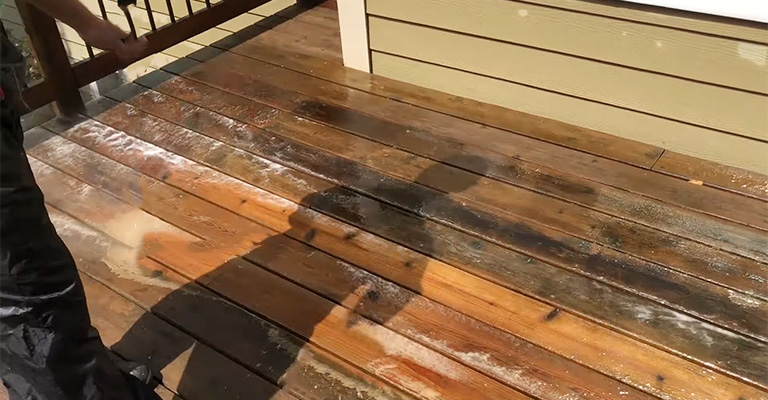
The stain may permanently damage the deck stain if it has not thoroughly dried or cured.
It Rained When It Wasn’t Supposed To! Now, What Should I Do?
Wash the deck with Cabot’s Deck Clean while it’s still damp once the rain has stopped. Using this method will ensure that any dirt or debris brought in by the rain is removed. Apply the second and third coats after the first is dry.
Rain on Deck Stain Issues?
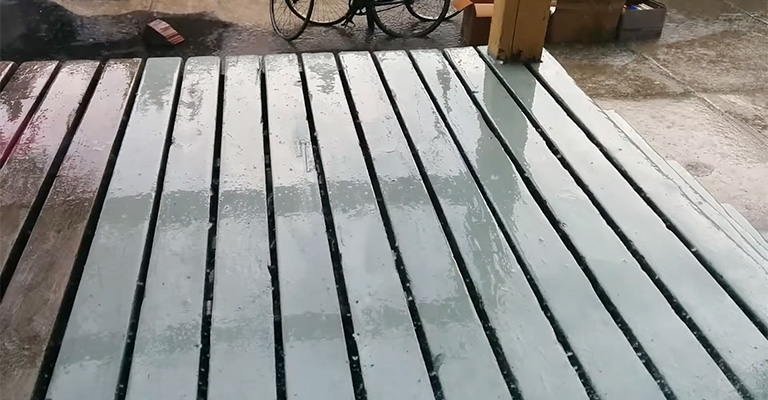
Usually, a dime-sized pocket, blotch, or white spot can be found on the paper. The rain may have caused some damage if any of these are present. If you plan on recoating or adding a second coat, read the instructions on the stain can.
If you are within the recommended time frame for another coat, try applying the stain to an inconspicuous spot to see if it fixes the damage caused by rain.
It may also be possible to rinse out the spots without damaging the stain if a light recoat does not resolve the problem.
It may be necessary to lightly sand the rain spots and recoat them. The stain must be applied lightly rather than overapplied to avoid other problems, such as peeling and flaking.
It might be necessary to strip off the stain with a deck stain stripper and start all over if you cannot resolve the problem by washing or sanding, and recoating.
How To Fix Rain Damage on a Stained Deck?
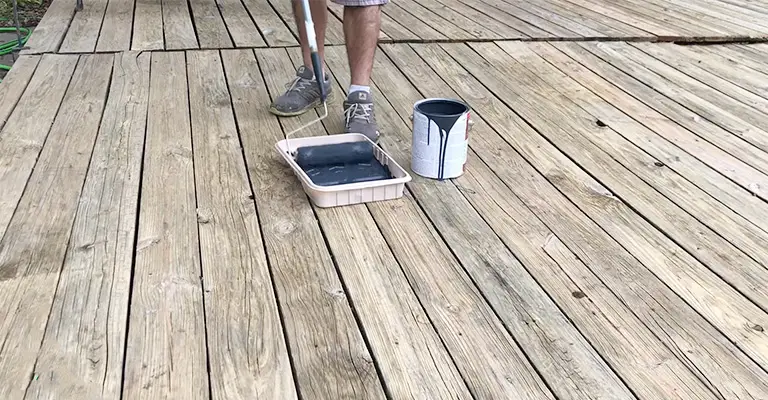
The best way to repair rain damage on a stained deck isn’t one size fits all. Because the extent of damage to a stained deck following a downpour can vary significantly, a different approach may be necessary.
It is nevertheless possible to damage a stained deck by water in either of two ways: minor or major.
Fixing Major Rain Damage on a Stained Deck
Occasionally, the rain doesn’t play nice, resulting in an unsightly mess. There are several telltale signs of significant rain damage, including extensive peeling and flaking of the stain coat.
When this happens, there is only one solution-to start over again from scratch. You can do this in the following ways:
1. Use a Deck Stain Stripper To Remove the Damaged Stain Coat
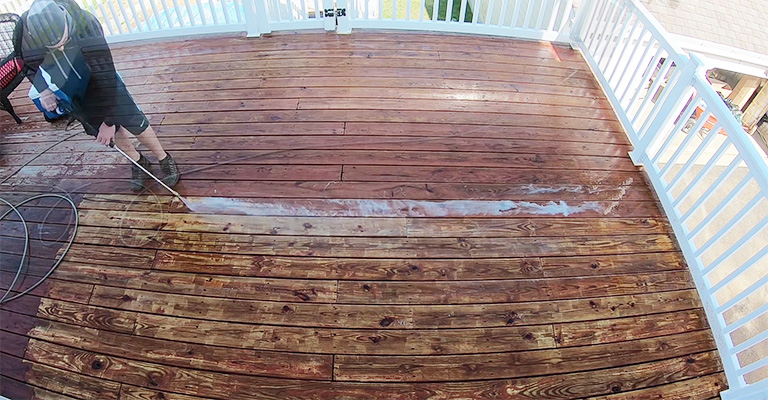
An old stain must be removed before you can apply a new one. Since wood is stainable, it is designed to be protected from the elements and give it an elegant appearance.
To ensure a smooth finish, you should strip the old stain and allow the new one to penetrate the wood pores.
It is most efficient and effective to use a wood stain stripper to remove undesirable deck stains. Pressure washing helps remove wood stains safely by softening them with caustic ingredients, such as sodium hydroxide.
It is recommended to use Restore-A-Deck Wood Stain Stripper. This product removes both transparent and semi-solid stain coatings and rejuvenates the wood.
To achieve the desired results, you might have to apply the stripper several times for solid-colored stains. As well as being environmentally friendly, it is also safe to use.
2. Pressure Wash the Stained Deck
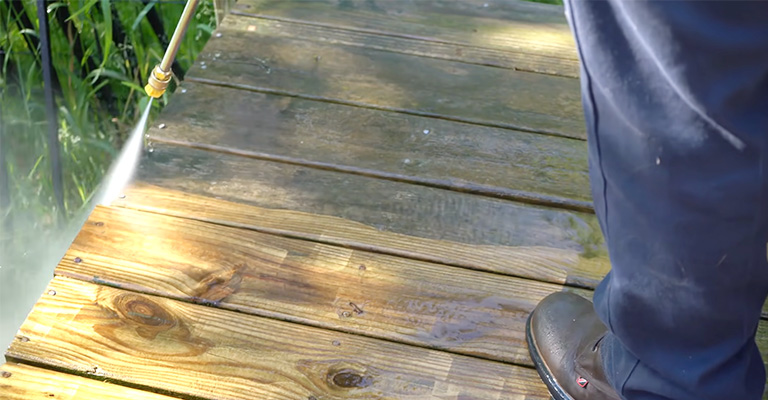
In the woodworking community, pressure washing a deck has been controversial for many years. It is said to be the best technique for removing stubborn dirt and stains from wood.
Users of this technique say it works well because it can get deep into the wood. Power cleaning can sometimes weaken a structure by destroying lumber’s structural integrity.
While both approaches can be effective, you can find a happy medium by using moderate amounts of pressure to deep-clean your deck. Even so, the best pressure will depend on the wood that makes up your deck.
Whenever possible, I recommend using the lowest pressure setting possible on softwoods, such as pine, or cedar-between 500 and 600 psi (pounds per square inch).
The hardness of hardwoods makes them more resilient to higher pressures, up to 1500 pounds per square inch.
3. Apply Wood Brightener To Your Deck
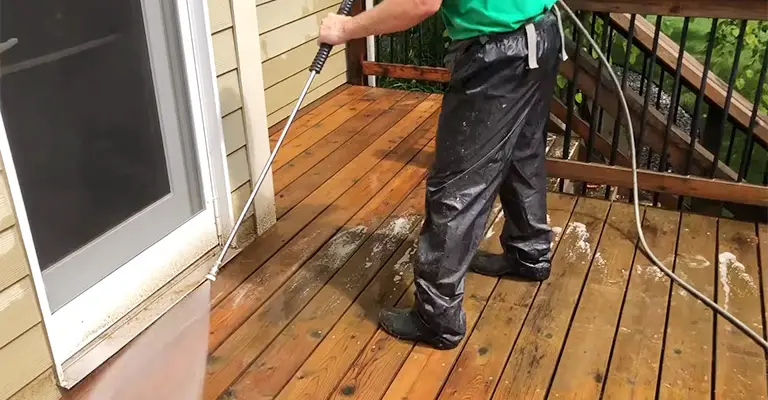
After washing your deck, apply a wood brightener to make your lumber more receptive to staining. Essentially, stain strippers change the pH of wood, which makes it difficult for new stains to adhere.
Using a wood brightener, you can restore the pH level of the lumber, help clear up the pores, and make it less absorbent, so that you can apply different types of stains.
You can restore the look of your deck by using the Restore-a-Deck Wood Brightener available online.
This product neutralizes stain strippers, brightens, and repairs wood, and makes your deck more absorbent so it can absorb a fresh stain. In addition, the price is pretty reasonable.
4. Sand Your Deck With 80-Grit Sandpaper
Before applying a stain, sanding the deck is essential. Through this procedure, you open up the wood’s pores, allowing the stain to penetrate deeply.
It is, however, impossible to use any kind of sandpaper. Fine sandpaper, for instance, can pack the pores of the wood with dust, making it harder for the stain to absorb. Conversely, coarse sandpaper can damage your deck’s lumber, especially softwoods.
If sanding your deck, it would be best to use 80-grit sandpaper. Both the fineness and the roughness are appropriate.
To give the deck a uniform appearance, sand it carefully and methodically. Remove dust once you have sanded it with a vacuum cleaner.
5. Apply Your Stain and Allow Adequate Drying Time
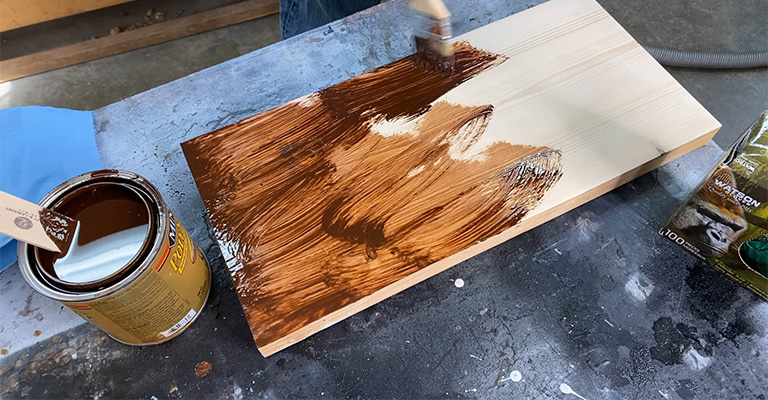
Since all this effort has been thrown out of the window due to the previous downpour, the last thing you need is yet another shower.
Hence, you should check the weather forecast before applying another stain to your freshly prepared deck.
You should wait at least a week before you start working. Ensure your deck has dried entirely by giving it at least 72 hours after you have prepared it. This is because moist lumber does not stain easily because its pores are clogged with moisture.
A freshly stained deck usually takes 48-72 hours to be fully set. Therefore, you must wait at least a week before adding another stain. Otherwise, your efforts will be wasted.
It is better to wait than take a chance if the weather forecaster cannot provide that assurance.
Water-based wood stains usually set much faster than oil-based ones and can dry in as little as six hours, allowing your deck to be used immediately.
While oil-based wood stains typically take 48 hours to set and dry, water-based stains usually take 48 hours. Additionally, you should think about when each stain must be left on the deck before wiping it off.
Fixing Minor Rain Damage on a Stained Deck
No matter who you ask, including deck-staining experts and manufacturer instructions on the stain’s container, we all advise not staining your deck before consulting the weatherman.
Staining during “safe” days – when it is forecast that it won’t rain for a few days – will significantly mitigate the damage a downpour can cause to your deck.
If you do that, you will give your stain sufficient time to set in the wood, reducing the risk of it being washed away during a rainstorm. Nonetheless, mother nature can be unpredictable, sometimes surprising us with rain without warning.
A few spots or imperfections here and there are the worst that can happen to your stained deck if luck is on your side.
If the rain damage is merely surface, you can fix it quickly by reapplying the stain on the washed-out areas. It is preferred, however, to allow the deck to dry completely before reapplying the stain.
Applying stain to wet wood will result in shoddy work and a dirty-looking deck because it will not be absorbed adequately.
Taking Care Of Minor Damage Involves The Following Steps:
- Give the deck ample time to dry. After 48 hours, you should contact the company.
- Next, start working on the problem spots. There are different stain brands with different staining instructions and requirements. This is because different stain brands require other procedures for reapplying. Before reapplying, always make sure to carefully read the instructions provided by the manufacturer.
- Sand the washed-out areas and then apply a fresh layer of stain. When attempting to correct more visible imperfections, it is best to first experiment on an inconspicuous area. This will enable you to determine whether this course of action will be successful.
It’s Due To Rain. Should I Coat My Deck?
Not at all. When rain is forecast, you may want to hold off treating your deck until it’s safe to do so. Applying stain and/or oil to wood after it’s cooled and dry will penetrate better.
Water will soak into the wood and try to displace the stain if it rains within 48 hours of the treatment.
The result may be a blotchy, flaky appearance rather than a smooth, even appearance. After you have stained the wood, it will peel and flake off if it rains immediately thereafter.
Can I Coat My Deck When It’s Really Hot?
It’s not. If you want to coat your deck, wait until it is cool since that is when stains and oils will penetrate the deck the best.
Whenever the sun is directly on your deck or overcast, wait until the sun isn’t directly on the wood before coating it. When coating a hot deck, wait until it has cooled down before attempting to coat it.
What If It Rains 24 Hours After Staining The Deck?
Occasionally there are issues, but if the weather is cold or the stain was over-applied, there is always a possibility.
What If It Rains 12 Hours After Staining The Deck?
Ninety percent of the time, there would be no problems.
How Long Does The Deck Stain Need To Dry Before The Rain?
Answer: Stain brand, type of stain, and weather conditions can determine how long the stain lasts. The average time is 4-12 hours, but it can be longer.
Final Words
Having your freshly stained deck stained into an eyesore by the rain is extremely disheartening. You will take the appropriate action according to the extent of the damage.
Those areas that need attention can be fixed individually by applying a new stain over them if your deck is in good condition; save a few spots. When the stain flakes and the damage is extensive, you will have to strip it off and start over from scratch.






